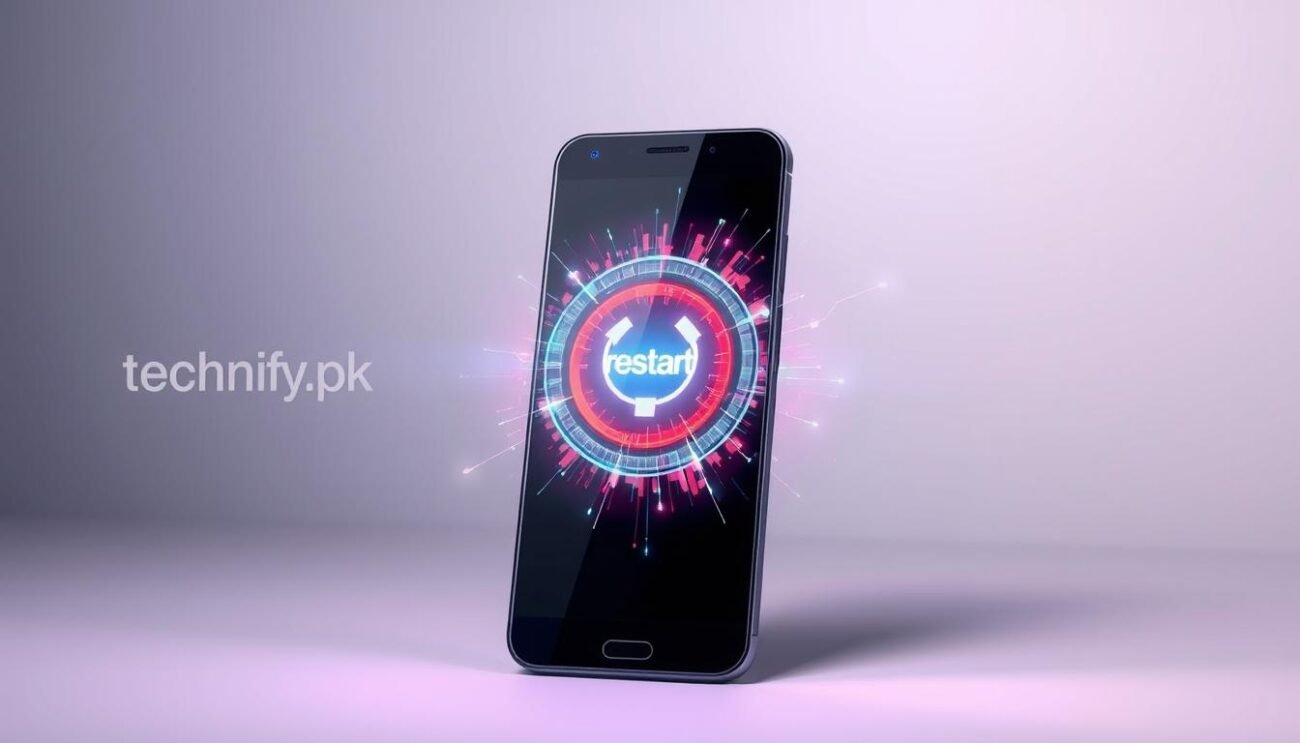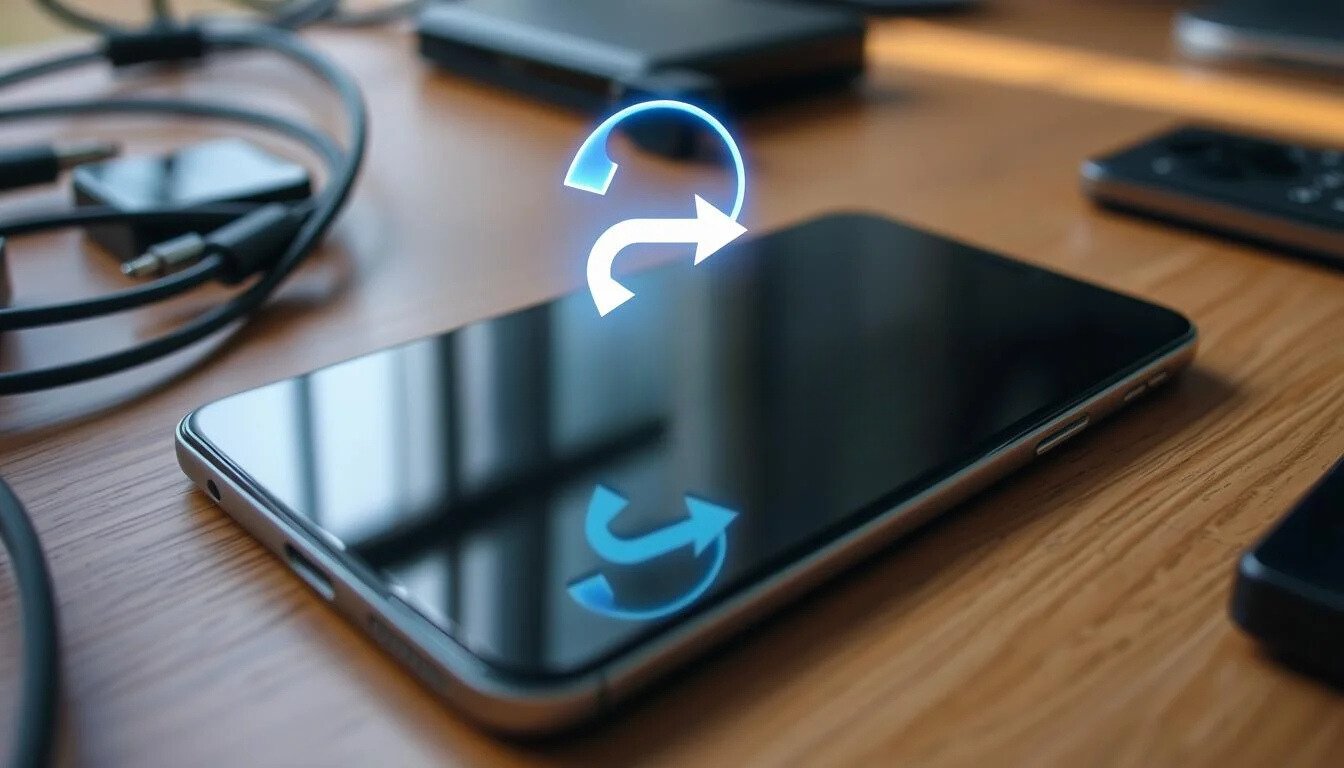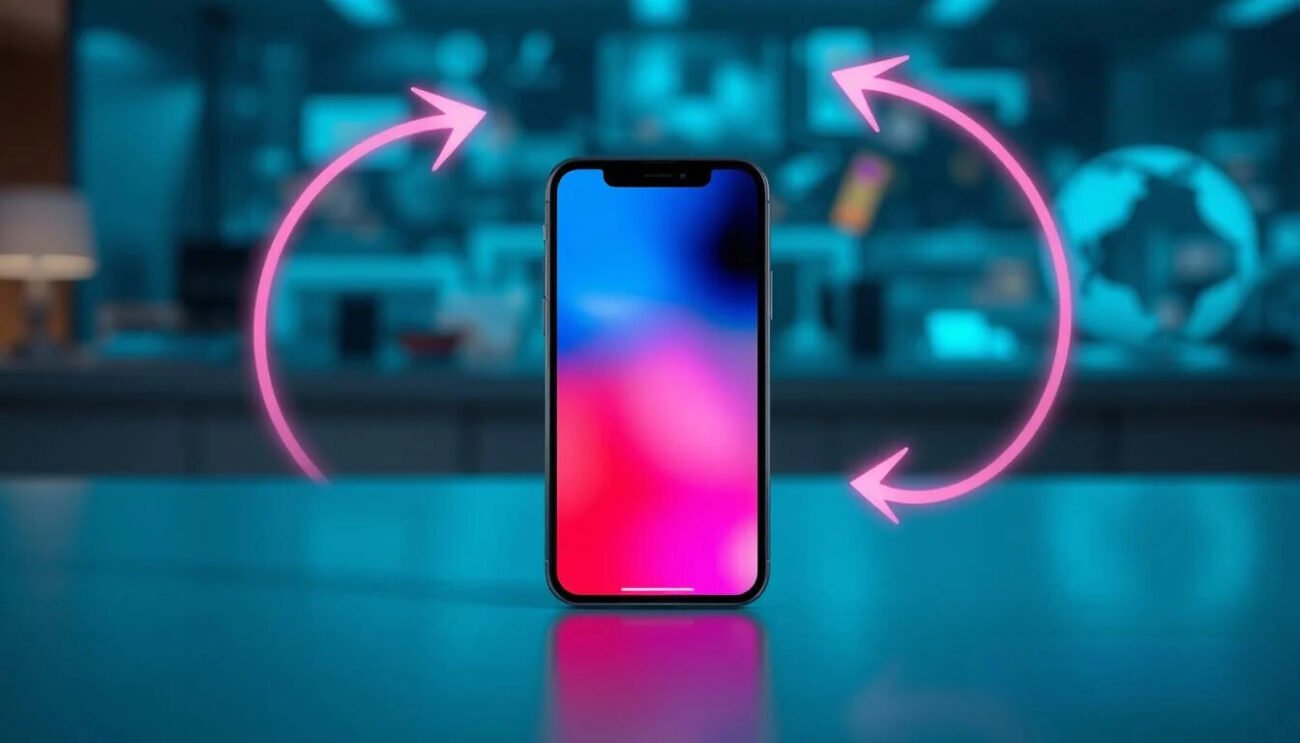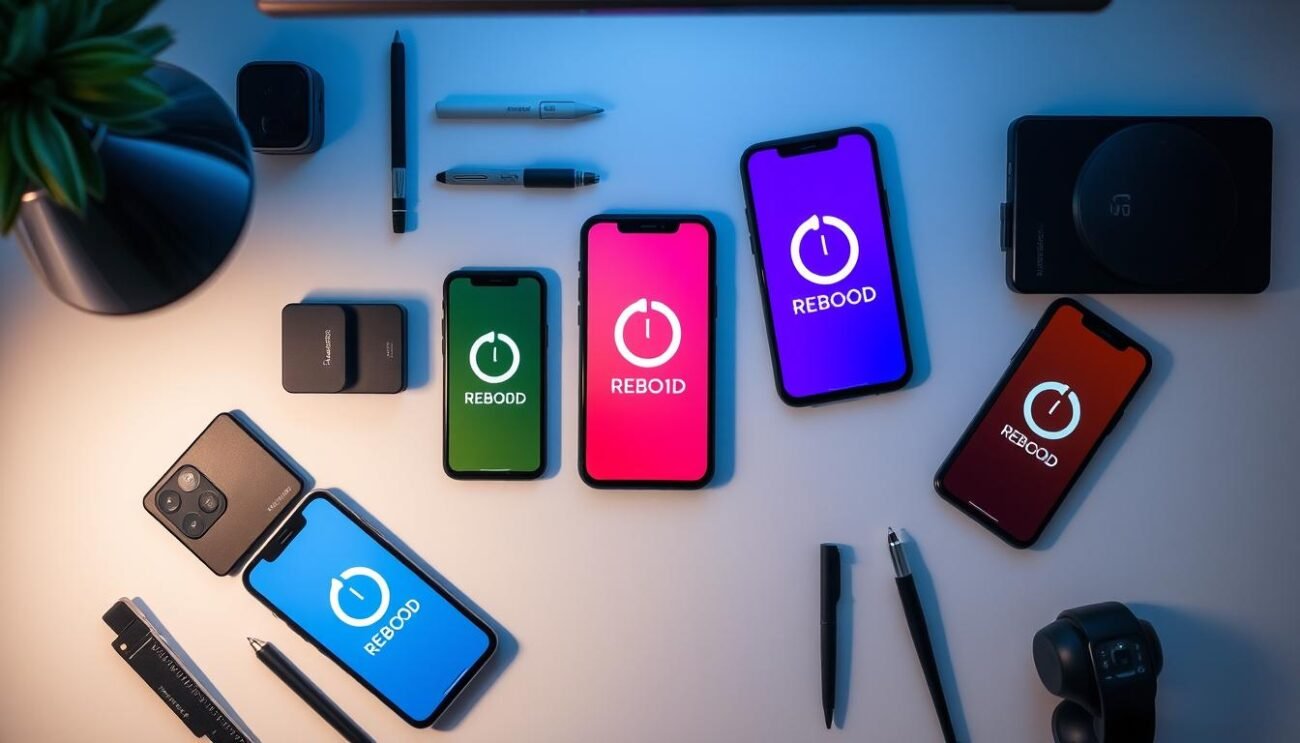Have you ever found yourself struggling with a sluggish, unresponsive phone, wishing for a simple fix? The solution may be as straightforward as restarting your device. But do you know the most effective methods for restarting your phone and the benefits it can provide? In this comprehensive guide, we’ll explore the when, why, and how of restarting your phone to keep it running at its best.
Key Takeaways
- Discover the common signs that indicate your phone needs a restart
- Understand the benefits of regularly rebooting your device for optimal performance
- Learn the different methods to restart both Android and iOS devices
- Explore the differences between a standard restart and a force restart
- Uncover best practices for power cycling your phone to ensure data safety and battery longevity
Understanding Why Your Phone Needs a Restart
In our fast-paced digital world, our smartphones have become indispensable companions, keeping us connected, entertained, and productive throughout the day. However, even the most advanced reset device can occasionally encounter issues that require a simple, yet effective solution a phone restart. Understanding the reasons behind this simple fix can help you maintain your device’s optimal performance and avoid frustrating malfunctions.
Common Signs Your Device Needs Rebooting
If you’ve noticed your restart mobile device running slower than usual, experiencing unexpected app crashes, or exhibiting other unusual behavior, it may be time for a restart. These common issues are often indicative of underlying software or system problems that can be resolved with a quick phone restart.
Benefits of Regular Phone Restarts
Regular phone restart routines offer numerous advantages for your device’s overall health and performance. By clearing the device’s memory, closing background processes, and refreshing the system, a restart can improve battery life, enhance app responsiveness, and even resolve persistent connectivity problems. Consistent reset device practices can help your smartphone run smoothly and efficiently, reducing the need for more complex troubleshooting measures.
Impact on Phone Performance
The impact of a phone restart on device performance can be quite substantial. By clearing the cache, stopping unnecessary background tasks, and allowing the device to start fresh, a restart can breathe new life into a sluggish restart mobile device. This can result in faster app launches, smoother multitasking, and improved battery life – all contributing to an enhanced user experience.
“Regularly restarting your device is like giving it a fresh start, allowing it to run at its best.”
Different Methods to Restart My Phone
Restarting your smartphone, whether it’s an Android device or an iOS device, is a simple yet effective way to troubleshoot issues and improve performance. There are typically two main methods to restart your phone: a standard restart and a force restart.
Standard Restart
A standard restart is the most common and straightforward way to reboot your smartphone. The process involves holding down the power button until the device shuts off, then turning it back on. This method allows your phone to go through a complete shutdown and startup sequence, which can help clear temporary glitches and free up system resources.
Force Restart
In some cases, a standard restart may not be enough to resolve more persistent problems. A force restart, also known as a hard reset, is a more aggressive method that can help when your phone is unresponsive or frozen. The steps to perform a force restart vary depending on your device, but generally involve pressing and holding a combination of buttons (such as the power and volume buttons) for several seconds until the phone reboots.
It’s important to note that while force restarts can be effective in addressing stubborn issues, they should be used with caution, as they can potentially result in data loss if not performed correctly. Always consult your device’s user manual or manufacturer’s instructions for the proper force restart procedure.
“Regularly restarting your smartphone can help maintain its overall health and performance.”
Regardless of the method you choose, restarting your smartphone, Android device, or iOS device can be a simple and effective way to address a variety of issues, from app crashes to system glitches. By understanding the different restart options available, you can quickly troubleshoot and resolve problems with your device.
Standard Restart vs. Force Restart: What’s the Difference
When it comes to restarting your phone, there are two primary methods: standard restart and force restart. Understanding the distinction between these two approaches can help you effectively troubleshoot and address various issues with your device.
When to Use Standard Restart
By addressing security-related messages, verification problems, and account settings issues, you can effectively resolve various Apple device messages and iPhone alerts that may be impacting your messaging experience. For insights into the latest Apple advancements, such as the iPhone 15 Pro Max’s back design and features, check out this detailed guide. Remember, seeking assistance from Apple’s support team or a qualified technician can be invaluable when dealing with persistent display message authentication errors.
When Force Restart is Necessary
A force restart, or hard reset, is a more drastic measure used when your phone becomes unresponsive or frozen. This method involves forcibly powering down the device, often by holding down a specific combination of buttons for several seconds. A force restart can help clear more severe software problems and can be particularly useful if your phone is stuck in a boot loop or not responding to any input.
Safety Considerations for Both Methods
While both standard and force restarts are generally safe, it’s important to exercise caution. Ensure you have backed up any critical data before attempting a restart, as the process may result in temporary data loss. Additionally, be mindful of your device’s specific restart instructions, as the button combinations may vary depending on the make and model.
| Method | When to Use | Potential Risks |
|---|---|---|
| Standard Restart | For minor software issues, to improve battery life and memory usage | Temporary data loss, but generally safe |
| Force Restart | When the device is unresponsive or stuck in a boot loop | Potential for more significant data loss, requires specific button combinations |
By understanding the differences between standard and force restart, you can confidently restart my phone or device restart to troubleshoot and maintain the optimal performance of your mobile device.
How to Restart Android Devices
Restarting your Android smartphone or tablet can be a simple yet effective way to troubleshoot various issues and improve device performance. Whether you own a Samsung Galaxy, Google Pixel, or any other popular Android brand, the process of restarting your device is fairly straightforward. In this section, we’ll guide you through the steps to reboot android, restart smartphone, and reset device effectively.
Standard Restart Method
To perform a standard restart on your Android device, follow these steps:
- Locate the power button, typically on the side or top of your device.
- Press and hold the power button for a few seconds until the device’s menu options appear.
- Select the “Restart” or “Reboot” option from the menu.
- Your device will now shut down and automatically restart, clearing the device’s memory and refreshing the system.
Force Restart Technique
In some cases, your Android device may become unresponsive or frozen, requiring a more forceful restart approach. To force restart your device:
- Press and hold the power button and the volume down button simultaneously for about 10-15 seconds.
- This will forcefully shut down your device and restart it, often resolving any software-related issues.
| Device | Standard Restart | Force Restart |
|---|---|---|
| Samsung Galaxy | Press and hold the power button, then select “Restart” | Press and hold the power and volume down buttons for 10-15 seconds |
| Google Pixel | Press and hold the power button, then select “Restart” | Press and hold the power and volume down buttons for 10-15 seconds |
| OnePlus | Press and hold the power button, then select “Restart” | Press and hold the power and volume down buttons for 10-15 seconds |
Remember, regularly restarting your smartphone can help maintain its optimal performance and address various software-related issues. By understanding the different methods to reset device, you can quickly and effectively troubleshoot and maintain your Android device.

Guide to Restarting iOS Devices
Restarting your iOS device, whether it’s an iPhone or iPad, can be a simple yet effective solution to various technical issues. From troubleshooting performance problems to resolving software glitches, a timely reboot can often breathe new life into your mobile device. In this section, we’ll provide step-by-step instructions for restarting different iOS models, covering both standard and force restart methods.
iPhone Models with Face ID
For iPhone models equipped with Face ID, such as the iPhone X, XS, 11, and 12 series, the restart process is as follows:
- Press and hold the Side Button and either Volume Up or Volume Down button simultaneously until the Power Off slider appears.
- Drag the slider to the right to turn off your iPhone.
- Wait a few seconds, then press and hold the Side Button until the Apple logo appears to power your device back on.
iPhone Models with Home Button
For iPhone models with a physical Home button, such as the iPhone 8 and earlier, the restart process is slightly different:
- Press and hold the Side (or Top) button until the Power Off slider appears.
- Drag the slider to the right to turn off your iPhone.
- Wait a few seconds, then press and hold the Side (or Top) button until the Apple logo appears to power your device back on.
iPad Restart Instructions
The restart process for iPads is similar to iPhones with Face ID:
- Press and hold the Top Button and either Volume Up or Volume Down button simultaneously until the Power Off slider appears.
- Drag the slider to the right to turn off your iPad.
- Wait a few seconds, then press and hold the Top Button until the Apple logo appears to power your device back on.
Remember, regularly restarting your iOS devices can help maintain optimal performance, resolve software issues, and ensure a seamless user experience. By following these simple steps, you can easily reboot your iPhone or iPad and keep your mobile devices running smoothly.
Troubleshooting Common Restart Issues
If you’re experiencing difficulties when trying to restart your phone, you’re not alone. Many users encounter various challenges, from frozen screens to unresponsive buttons. Fortunately, there are several troubleshooting tips and alternative methods to get your device back up and running. For a detailed guide on rebooting different devices, check out this quick guide for every device.
One common issue is a frozen or unresponsive screen. In such cases, a force restart may be necessary. To force restart your Android device, press and hold the power button for about 10-15 seconds until the screen goes blank and the phone reboots. For iOS devices, press and quickly release the volume up button, then the volume down button, and finally press and hold the side button until the Apple logo appears. If you’re using an iPhone 7 and need to enter recovery mode, refer to this quick guide on recovery mode.
If the standard restart or force restart methods aren’t working, try these additional troubleshooting steps:
- Charge your phone’s battery fully and then attempt to restart it.
- Check for any software updates and install them, as they may resolve the issue.
- Try a safe mode restart, which temporarily disables third-party apps and can help identify any software-related problems.
- As a last resort, you may need to perform a factory reset, which will erase all data on your device. Be sure to back up your important information beforehand.
Remember, if you’re still having trouble restarting your phone or rebooting your device after trying these troubleshooting steps, it’s best to seek professional assistance to ensure your phone is functioning correctly and prevent further issues.
“A simple device restart can often resolve a wide range of technical problems, from app crashes to system freezes.”
Best Practices for Power Cycling Your Device
Regularly power cycling your smartphone or tablet can significantly improve its overall performance and longevity. By following a few best practices, you can ensure your device operates at its peak and maintain its health for years to come.
Optimal Timing for Restarts
Experts recommend restarting your power cycle, reset device, or restart smartphone at least once a week, if not more frequently. This helps clear the device’s memory, close any background processes, and ensure all software updates are properly applied.
Data Safety During Restarts
Before restarting your device, it’s crucial to back up any important data, such as contacts, messages, and photos. This will ensure your information is protected in case of any unexpected issues during the power cycle or restart smartphone process.
Battery Considerations
- Avoid restarting your device when the battery is low, as this can potentially cause data loss or other problems.
- If possible, restart your device while it’s plugged in to ensure the battery doesn’t run out during the reset device process.
- Monitor your device’s battery health and consider replacing the battery if it no longer holds a charge for a reasonable amount of time.
| Tip | Description |
|---|---|
| Optimal Restart Frequency | At least once a week, if not more frequently |
| Data Backup Before Restart | Back up important data to ensure safety during power cycle |
| Battery Considerations | Restart when battery is not low, and preferably with device plugged in |
By following these best practices for power cycling your device, you can help maintain its peak performance and ensure a longer lifespan for your smartphone or tablet.
When to Seek Professional Help
While most phone restart issues can be resolved through standard or force restart methods, there may be situations where seeking professional assistance is necessary. If you encounter persistent restart problems or encounter hardware-related difficulties, it’s important to know when to contact customer support or visit a repair center.
Here are some key indicators that it’s time to seek professional help for your restart mobile, phone restart, or device restart issues:
- Your phone or device continues to experience frequent, unexplained restarts despite following troubleshooting steps.
- You suspect hardware damage, such as a cracked screen or port issues, that may be causing restart problems.
- The device is no longer responding to any restart commands, indicating a more complex software or system failure.
- You’ve tried all the recommended restart methods, but the device still fails to power on or function properly.
In these cases, it’s best to reach out to the manufacturer’s customer support team or visit an authorized repair center. They can perform a thorough diagnostic, identify the root cause of the restart issues, and provide appropriate solutions, whether that’s a software update, hardware replacement, or more advanced troubleshooting.
“When it comes to persistent device restart problems, don’t hesitate to seek professional help. Attempting to fix complex issues on your own can potentially make the situation worse.”
Remember, the sooner you address recurring phone restart problems, the better. Ignoring them can lead to further complications and potentially irreparable damage to your device. By working with trained experts, you can get your phone or tablet back in working order and avoid any costly mistakes during the troubleshooting process.

Conclusion
In conclusion, regularly restarting your phone, be it an Android or iOS device, is a crucial step in maintaining its optimal performance and addressing various issues. From understanding the common signs that indicate the need for a restart to exploring the differences between standard and force restarts, this guide has provided you with the necessary knowledge to regain control over your device’s functionality.
By following the step-by-step instructions for restarting your Android or iOS device, you can now confidently tackle common problems and ensure your phone continues to run smoothly. Remember, regular restarts, reboots, and resets can significantly improve your device’s overall responsiveness, battery life, and overall user experience.
If you ever encounter persistent issues that a simple restart cannot resolve, don’t hesitate to seek professional help. With the insights gained from this article, you are now equipped to make informed decisions about the maintenance and care of your smartphone, empowering you to get the most out of your device and stay connected seamlessly.
















































